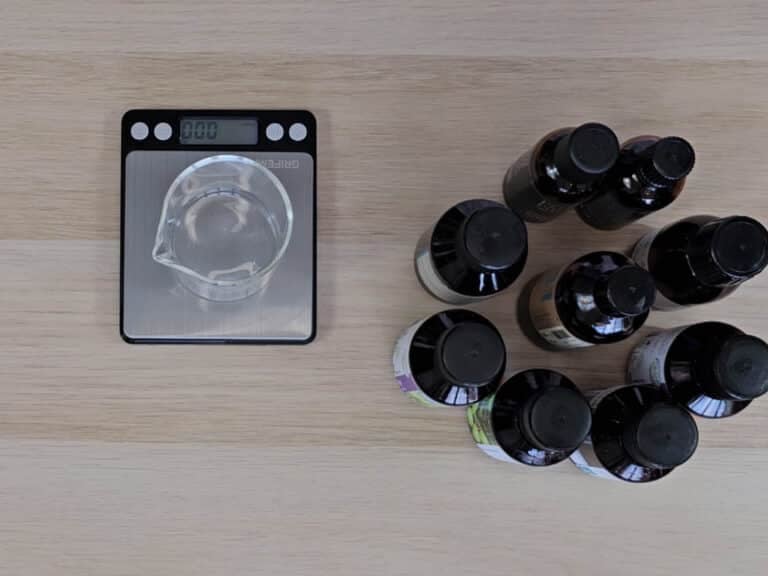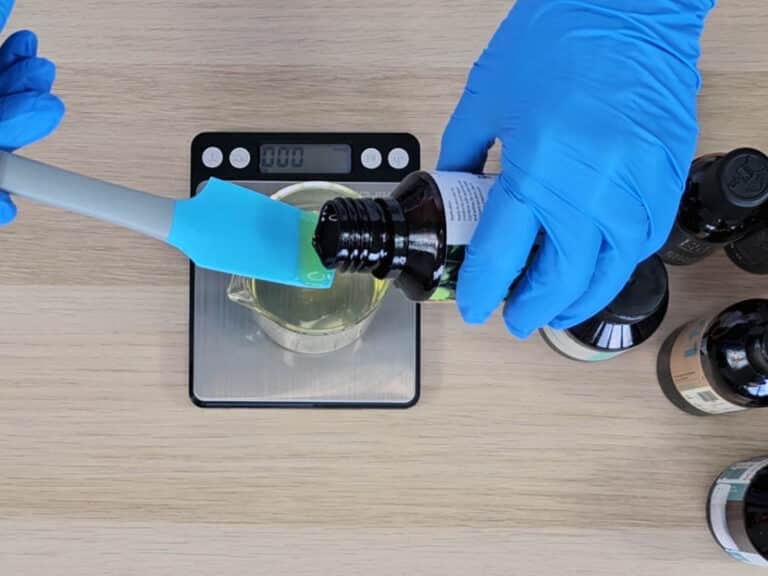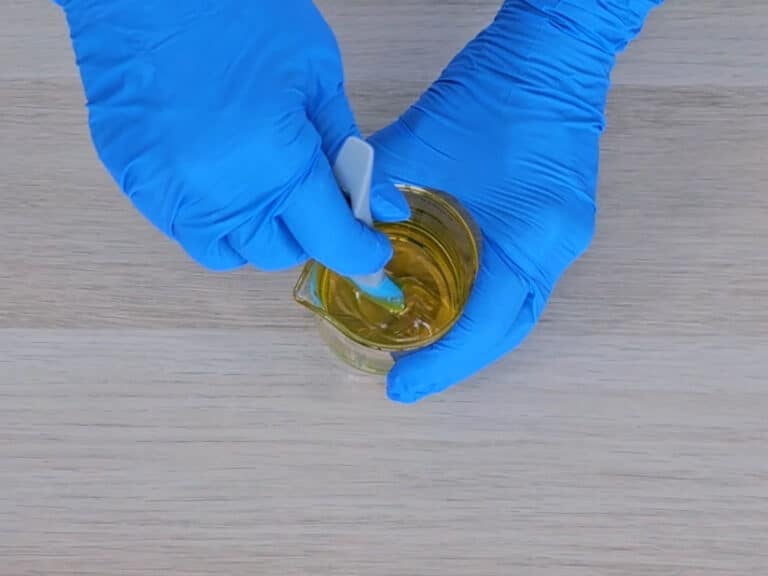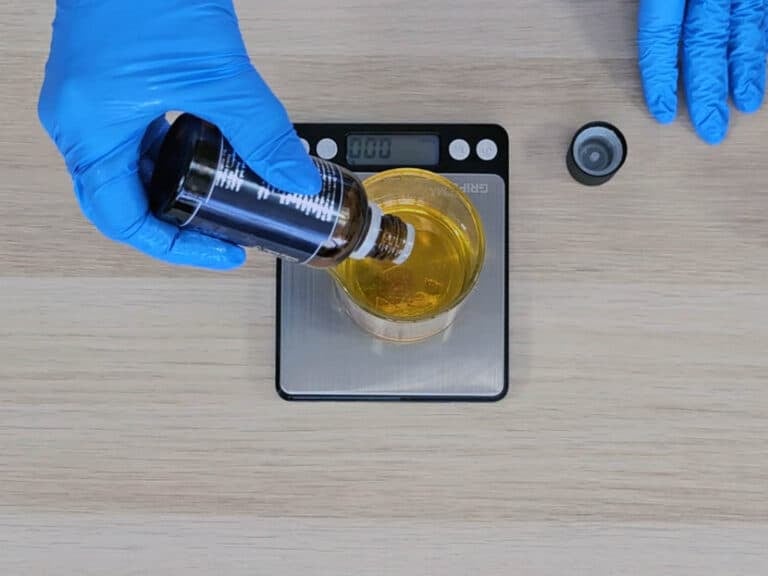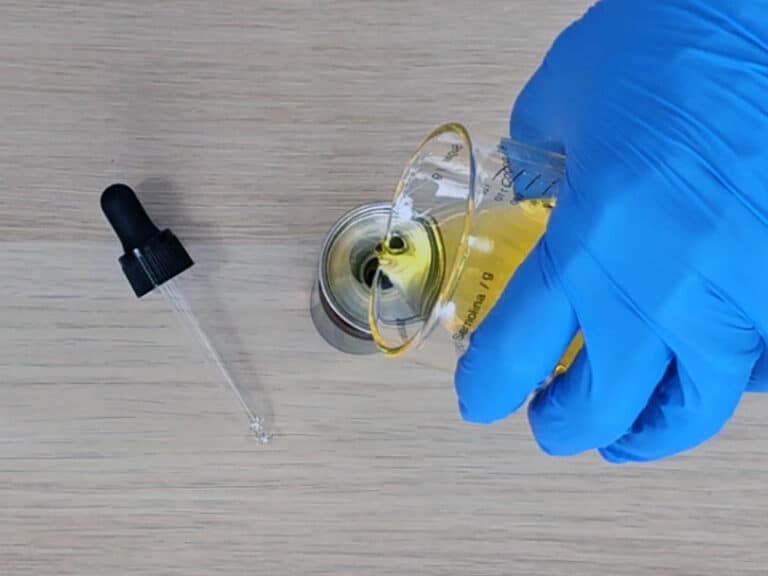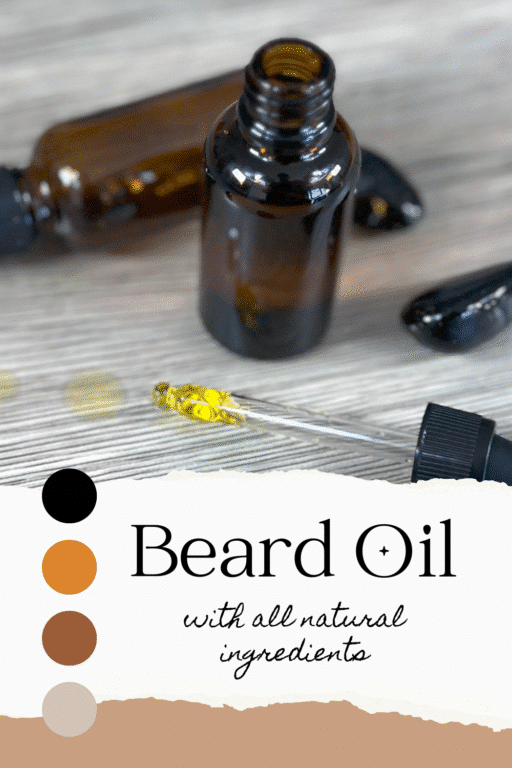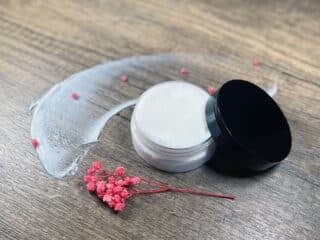I didn’t start learn how to make beard oils because they were trendy. I started because my husband’s face felt like a cactus got into a fight with a brillo pad.
If, like him, you’re fighting itch, beardruff, or wiry ends that catch on your shirt collar, a simple beard oil can be the small daily habit that flips everything. Like totally flips it. It softens the hair, nourishes that skin underneath, and makes the whole situation look tidy instead of tired.
In this post, im gonna show you how a simple beard oil can be built with basic, affordable ingredients, and then how to level it up. The detailed recipe below covers a luxury beard oil I’ve been whipping up for hubby and honestly he’s loving it. But the principles apply to any good facial hair oil.
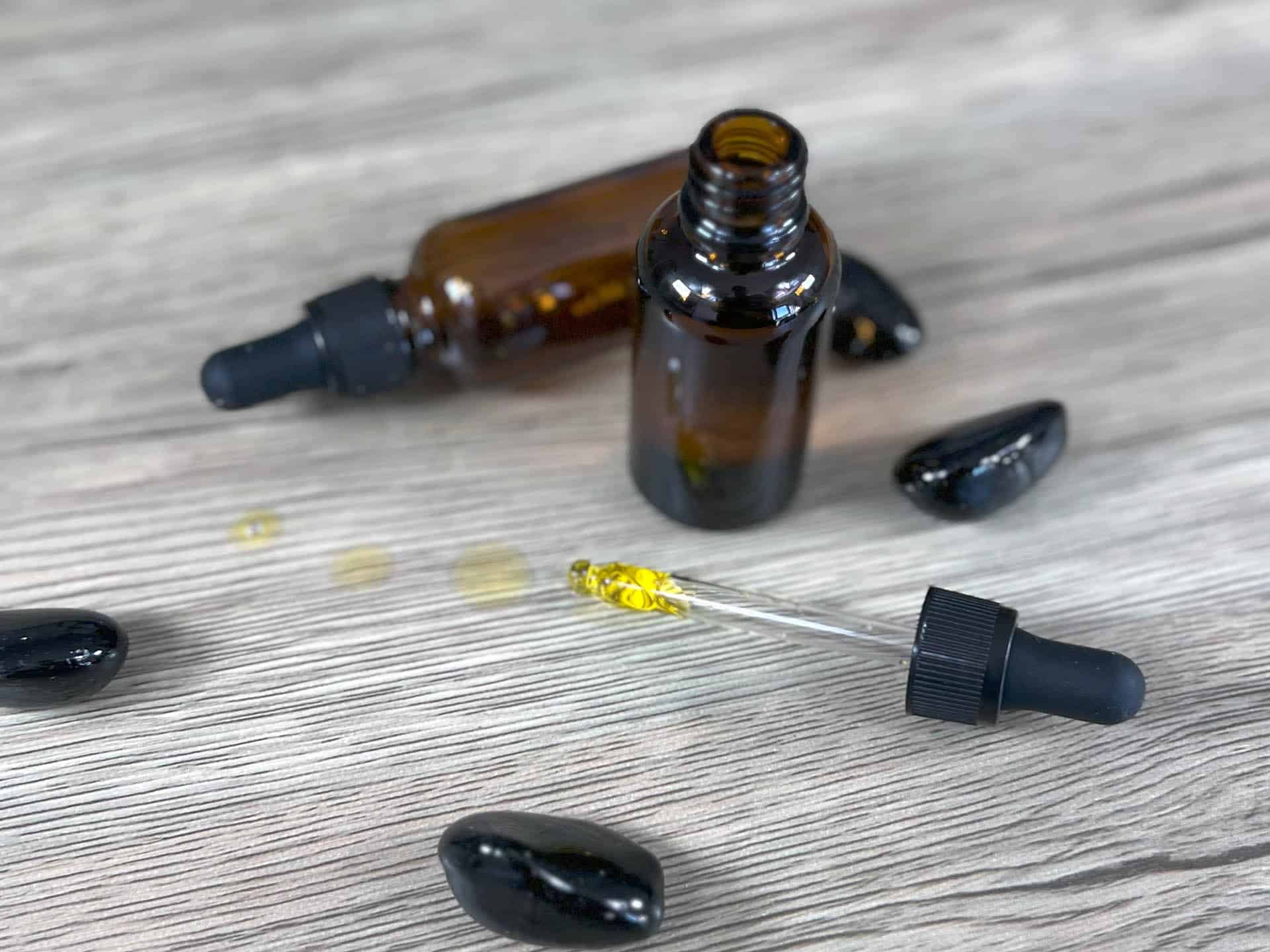
And since people ask, yes, beard oil is totally meant to stay on. You can even leave it on overnight if you want. Come morning, your skin or beard will be glowing! And this sounds crazy… but even I’ve used it. Not for my beard, but it doubles as an amazing face oil. We were travelling a few weeks ago, and I forgot some of my DIY skin care. It literally saved my skin while we were on vacation!
Watch How To Make Beard Oil At Home
Why This Beard Oil Will Change Your Routine
A good beard oil recipe does two things at once.
It conditions the hair so it bends instead of snapping. Then, it replaces some of the natural oils our cleansers and hot water strip from the face. No wonder so many people want to learn how to make beard oil. That means less itch, fewer flakes and a beard that sits closer to how you want it not how it woke up.
You can use it once a day if your climate is mild or your beard is short.
But I’d recommend using it twice a day if your environment is dry, your beard is very coarse, or it’s quite long. On shorter beards, every other day can be enough on calm weeks too. Ideally, you’ll wanna experiment to see what works for you and your beard.
Beard oil won’t magically grow new follicles, and I think it’s helpful to say that out loud. Genetics and hormones run the growth show, supported by the basics like decent sleep, protein, and micronutrients. You can help the playing field, though, with healthy skin, occasional gentle exfoliation, and smart tools like a derma roller to nudge circulation. Think of beard oil as your daily maintenance and comfort layer, not a miracle serum.
Making A Simple Beard Oil
Great beard oils could be made up of easily accessible and economical oils, something like jojoba oil, sweet almond oil, sunflower oil, or coconut oil are all great choices.
Mix two or more of these oils, then add a few drops of your favorite essential oil. Tea tree, peppermint, lavender, black spruce, sweet orange, cedarwood, and frankincense are all good choices. Antioxidants such as vitamin E or rosemary C02 extract can also be added for longevity
Taking it to the next level
- Olive Squilane, Argan Oil, Abyssinian Oil, Baobab Oil, and Sea Buckthorn Fruit Oil are all high-end carrier oils that will enhance the product.
- Adding an active ingredient such as Bisabolol, Calendula, Raspberry seed, Chamomile CO₂ Extract, and Sea buckthorn can bring extra shine and conditioning.
Ingredient Spotlight: the good stuff in my beard oil recipe
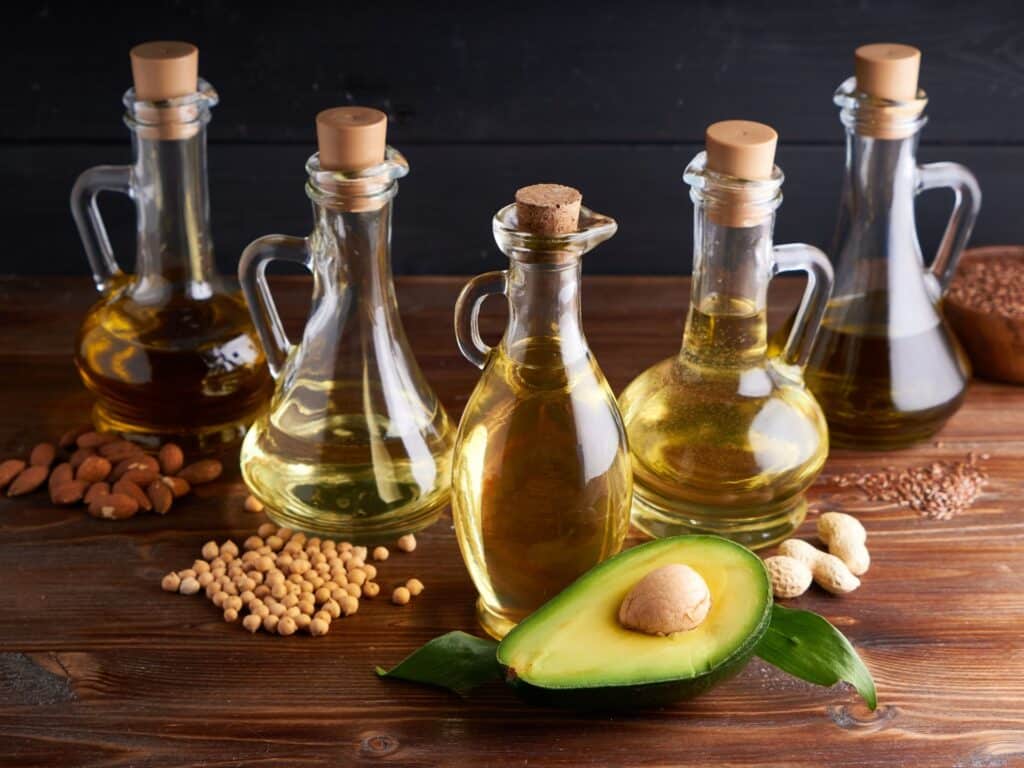
I built the luxury blend in the recipe card to feel silky, sink in quickly, and leave a healthy sheen without greasiness. A few of its stars:
Argan oil
Argan is like that reliable friend who always shows up. It’s richly conditioning and helps soften rough ends without making the whole beard collapse into a slick. More importantly, it helps to tame frizz and restores elasticity, making your beard stronger and more resiliant. If you need a swap, sweet almond offers similar glide and is easy to find. Sunflower is another friendly stand-in if your skin prefers something very light.
Jojoba oil
Technically a liquid wax, jojoba behaves a lot like what our skin naturally produces. That “skin-identical” personality helps with balance, so you get softness without a shiny film. If jojoba isn’t available, try fractionated coconut oil for a light feel, or grapeseed for a fresh finish. For acne-prone skin, jojoba is usually a safer bet.
Abyssinian oil
This one gives slip. It spreads beautifully and adds shine that looks polished, not wet. If you want a simple alternative, rice bran or grapeseed can deliver a similar fast-absorbing touch.
Baobab oil
Nourishing and plush. I reach for baobab when a beard feels scratchy at the ends or the skin underneath looks windy-day tired. It’s also great at strengthening hair too, which is so important for growing a longer beard. If you don’t have it, try avocado or a bit of olive. Just know those feel a touch heavier, so balance them with lighter partners.
Olive squalane
Squalane is the secret to that weightless, silky finish. It’s stable, smooth, and plays nicely with skin. If you can’t find squalane, you can lean a little harder on jojoba to keep things non-greasy.
A quick honorable mention to sea buckthorn fruit oil in the luxury blend. It’s antioxidant-rich and gives that warm, sunset tint to the oil. It provides a lovely shine as well as helping to strengthen hair. It’s potent, though, and at higher levels it can lightly stain very pale hair or fabrics. Keep it modest and you’re golden.
Lastly, a quiet hero, vitamin E. An antioxidant to help slow rancidity, which means your bottle smells fresh longer. We don’t need a preservative for this product, because it’s anhydrous and therefore bacteria, mold and yeast or not able to grow. But a good quality antioxidant can help keep your all oil formulations fresher for so much longer.
Method Overview, minus the fuss
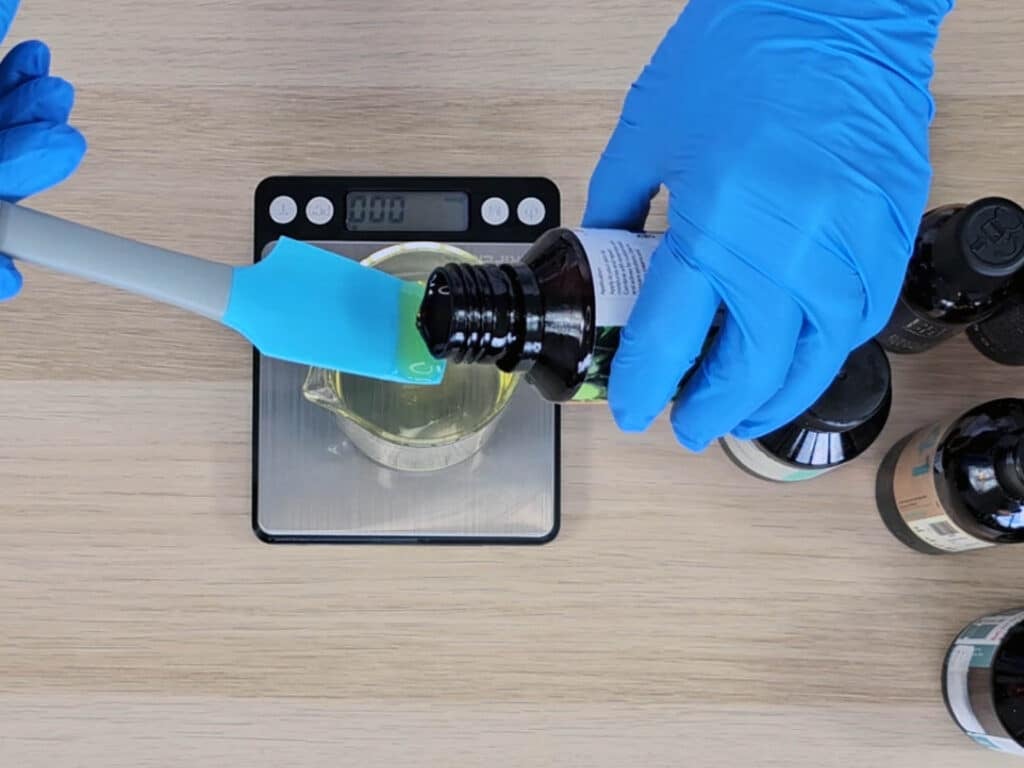
You wanna use clean and sanitized tools. Like that’s always my number one. I sanitize the bottle and let it dry completely. Then I simply combine my chosen carrier oils in a beaker at room temperature, stir until the blend looks uniform and clear, add my antioxidant and any essential oils, and funnel the lot into a dark glass dropper bottle. That’s it. If I have time, I let the filled bottle sit so microbubbles wander off and the scent marries. Then I label it. Done.
If you’re a visual learner, the recipe card below pairs with a short video of this exact luxury batch, start to finish. It’s oddly soothing.
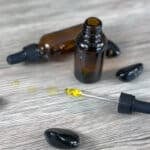
My Luxury Beard Oil Recipe
As an Amazon Associate, I earn from qualifying purchases. If you buy via the links here I may earn a small affiliate commission at no cost to you, please read my affiliate disclosure.
Equipment
- Funnel optional
Ingredients
- 22 grams Argan Oil
- 10 grams Jojoba Oil
- 7 grams Abyssinian Oil
- 5 grams Baobab Oil
- 2.5 grams Olive Squalane
- 2.5 grams Sea Buckthorn Oil
- 0.5 grams Vitamin E Oil
- 0.25 grams Peppermint Essential Oil
- 0.25 grams Tea Tree Essential Oil
- 2oz Dropper Bottle
Instructions
- Place a clean, sterilized beaker onto the digital scale and press the tare button.
- In order of appearance (in our video), pour in the carrier oils, to include Argan Oil, Jojoba Oil, Abyssinian Oil, Baobab Oil, Olive Squalane, and Sea Buckthorn Fruit Oil.22 grams Argan Oil, 10 grams Jojoba Oil, 7 grams Abyssinian Oil, 5 grams Baobab Oil, 2.5 grams Olive Squalane, 2.5 grams Sea Buckthorn Oil
- Give the mixture a stir with your spatula.
- Next, add the Vitamin E and the essential oils. The stir again.0.5 grams Vitamin E Oil, 0.25 grams Peppermint Essential Oil, 0.25 grams Tea Tree Essential Oil
- Using a small funnel, transfer the oils to a clean, sterile bottle.2oz Dropper Bottle
Tips and mistakes to avoid
- Don’t chase hold from beard oil. Oil softens and conditions. It doesn’t fix your mustache into a perfect swoop. If you want shape memory, use a balm or a wax after your oil.
- Apply to damp, clean hair. Right after a shower or face wash, when your beard is just towel-damp, oil spreads evenly and locks in water. On a fully dry beard, it sits on top.
- Start with less than you think. A couple of drops can be plenty for stubble. Longer beards need more, but it’s still less than most people expect. You can always add a touch.
- Mind essential oils. A little peppermint gives a fresh tingle, tea tree smells clean, cedarwood reads outdoorsy. They also carry potential allergens, and some citrus oils can be sun-sensitizing. Stay skin-safe, patch test, and check IFRA guidance for leave-on face products.
- If you’re acne-prone, choose lighter carriers. Jojoba, squalane, and grapeseed are usually friendlier than heavy choices.
- The color caution. If your beard is very light, any strong orange or red oils can turn that gorgeous beard a bit gingery looking. Keep those at modest levels or save them for nighttime use.
- Storage, storage. Dark bottle, cool spot, cap tightly. Heat and light are the enemies of freshness.
Tiny anecdote: I once filled a bottle too quickly, skipped the rest, and wondered why the first few uses felt bubbly on his beard. Letting it settle made a bigger difference than I expected.
Substitutions and creative variations
As mentioned before, you don’t need a rare pantry to make good beard oil. Some simple, economical carriers that work beautifully:
- Jojoba, sweet almond, sunflower, fractionated coconut: Mix a few of these in roughly equal portions until the texture feels right in your palm. If it feels heavy, add more jojoba or try adding a little olive squalane to your mixture. If it disappears too fast, lean slightly richer with almond or a touch of avocado.
- Scent ideas, with restraint: tea tree for a clean gym-bag-friendly note; peppermint for a cool wake-up; lavender when you want a calmer evening blend; cedarwood or black spruce if you like woods. Sweet orange smells cheerful and is one of my favs.
- Next-level actives: a small amount of bisabolol, calendula extract, chamomile CO₂, raspberry seed oil, or sea buckthorn can add extra comfort, shine, and antioxidant support. Keep additions modest and patch test first.
Important guardrail: I’m not giving alternate formulas here. The exact luxury blend lives in the recipe card. Use these suggestions to tailor feel and scent, not to draft a whole new recipe from scratch.
Troubleshooting: common beard oil hiccups
- “My beard still feels greasy an hour later.” You’re likely using too much or leaning too heavy on rich oils. Use fewer drops and rebalance toward jojoba or squalane next time. Warm two drops between your palms, press into the skin under the beard first, then smooth the remainder through the lengths.
- “I’m still itchy.” Two things help. First, consistency. Apply every day after washing, and don’t forget the skin under the beard. Second, add gentle exfoliation one or two evenings a week. A soft washcloth works. Oil supports moisture, but dead skin needs a nudge to move along.
- “Breakouts appeared along my jawline.” It happens. Dial back the amount, cleanse well at night, and swap any heavier carriers for lighter ones. If you used a new essential oil, pause it and see if the irritation clears.
- “The scent is too strong.” Dilute by topping up your bottle with unscented carrier mix. Essential oils are potent and can be dialed way back while still catching a hint of freshness.
- “My oil looks cloudy.” Natural oils can go hazy in cooler weather. Warm the bottle between your hands. It should clear. If it smells sharp, like crayons or old nuts, it may be past its best.
- “It doesn’t help with styling.” Right, because beard oil conditions, it doesn’t hold. Layer a small amount of balm or wax after the oil for shape.
- “Orange tint on my pillowcase.” That’s likely from a highly pigmented ingredient. Use the blend sparingly at night, keep those pigmented oils modest, or switch to a lighter-colored evening version.
Storage and shelf life
Because beard oil is water-free, it doesn’t need a preservative. It does benefit from an antioxidant like vitamin E or rosemary extract to help slow oxidation. Use a dark glass dropper bottle, cap tightly after each use, and park it away from heat and sunlight. Treated kindly, a small bottle should stay fresh for many months. Your nose is a better calendar than the label. If the aroma goes from pleasant to stale or crayon-like, it’s time to mix a fresh batch.
Why it matters: rancid oil won’t hurt you in the way spoiled milk would, but it smells off and isn’t doing your skin any favors.
How to use beard oil for the best results
Here’s the routine we tested over many weeks with the luxury blend from the recipe card:
- After a shower or face wash, pat your beard so it’s damp, not dripping.
- Dispense a small amount into your palm, rub hands together to warm, and work it in. Start with the skin under the beard, then glide through the hair from roots to tips.
- Comb or brush to distribute and align the hairs. This step takes it from good to polished.
- Leave it on. Overnight is not only fine, it’s beneficial. You’ll get a softer beard in the morning and calmer skin.
- Frequency: short beards might do well every other day. Longer or coarser beards thrive with daily use; in dry climates or winter, morning and evening can be perfect.
Skin type notes:
- Go light. Jojoba and squalane shine here. Cleanse gently at night.
- Keep the essential oils minimal or none. Heavier carriers like baobab or avocado can help, balanced with a lighter partner so you don’t feel slick.
- Keep citrus essential oils low during daytime wear and be aware of potential sun sensitivity.
On growth: beard oil supports the environment, not the gene switch. Steady habits like exercise, sleep, a protein-rich diet, and a multivitamin or targeted nutrients such as vitamins A, C, D, E, biotin, iron, and zinc help your body do its part. A derma roller can be useful when used properly and sparingly. It’s the boring stuff, but it works over time.
Scaling and cost notes
One of the joys of a beard oil formula is that it’s built in percentages, which makes scaling up or down simple. Want to make a tiny tester bottle? Keep the ratios as written in the recipe card and reduce the total amount. Need a few gifts for friends? Multiply the batch while staying inside skin-safe ranges for fragrance.
A few practical pointers:
- Pricey carriers like argan, baobab, and specialty extracts are wonderful, but you don’t need large bottles unless you’re making oil regularly. Small sizes stay fresher and keep costs sensible.
- Luxury oils are fun, but an excellent beard oil can be made from simple carriers like jojoba, sunflower, and sweet almond.
- If a bottle will sit for months, keep it capped, cool, and in the dark. Air and heat are what nibble your investment.
- The actual hands-on time is short, which makes this a satisfying weekend project that pays off every morning.
While we’re talking cost, one honest downside of beard oil is that good ingredients aren’t free. There’s also a small risk of irritation if you overdo essential oils or choose a carrier your skin dislikes. Sun sensitivity from certain fragrances can be a thing. And oil won’t style your beard into a magazine cover without help. Knowing those trade-offs makes your purchase or DIY feel smarter.
A quick word about the exact batch I’m using
The luxury beard oil in the recipe card is the one we’ve been testing for the last stretch. It has that soft peppermint tingle on contact, the kind that wakes the skin without going mint-toothpaste. It glides on thanks to a mix of light and rich carriers, then sets to a natural finish that doesn’t smear on your phone. I poured mine into an amber dropper bottle, labeled it, and let it rest on the counter overnight. The next day it smelled a touch rounder and looked crystal clear. It also doubled as a nice pre-styler for his hair on a windy morning. Small joys.
Ready to mix?
If your beard is dry, itchy, or just not behaving, beard oil is an easy win. Start simple with accessible carriers and a light hand. Then, when you’re ready to indulge, try the luxury version in the recipe card below. It’s the one I keep on my sink now.
Scroll back up to view or print the full beard oil recipe, including exact ingredient amounts, step-by-step instructions, and the quick video walkthrough. If you try it, tell me how it went and what tweaks your beard loved. I learn something new every time someone mixes a batch.

